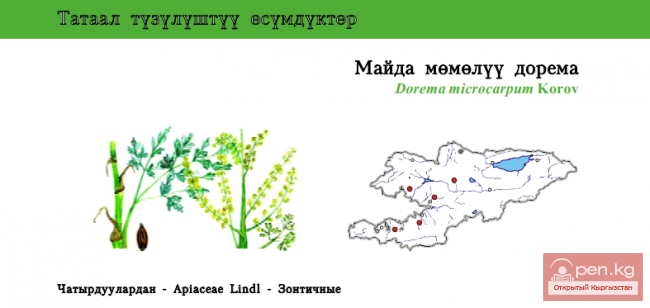
Aulie-Ata Stemmacantha Centaury Status: EN. A very rare species, critically endangered....

Edelweiss-like Pyrethrum Status: VU. Endemic species....

html Lamyropappus schakaptaricus Status: VU. A rare representative of a monotypic genus....

Golden Trichanthemis Centaury Status: VU. A rare narrowly endemic species of the Alai Ridge, an...

Kostychev’s Pascueflower Status: VU. A narrowly endemic and very beautiful plant, deserving...

Anomalous Alajja (Erianthera anomala) Status: VU. Endemic to the mountains of Central Asia. A rare...

Large-calyxed Primrose Status: VU. In Kyrgyzstan, it is a very narrowly distributed, rare,...

Eugenia's Primrose Status: VU. A narrow endemic rare, highly ornamental species. Found in...

Regel’s Eminium Status: VU. A rare endemic species of the Western Tien Shan....

Wolly-fruited Kosopoljanskia Status: EN. Endemic. One of the two species that are sub-endemic to...

html Korshinsky’s Meadow Saxifrage Status: EN. A rare endemic species found in small numbers and...

Glacial Pastinacopsis Status: EN. A rare endemic species of a monotypic genus in the Northern Tien...

Alai Bubblewort Status: VU. A rare narrowly endemic species....

Dorema microcarpum Status: VU. Rare endemic species....

Obtusilobous Windflower Status: VU. The westernmost boundary of its range in Kyrgyzstan is located...

Lepidolopha Komarovii Status: EN. An endemic species of mountainous Central Asia, representative...

Nathaliella alaica Status: CR B2ab(iii). A rare, endemic species of a monotypic genus of Himalayan...

Intermediate Hyalolaena Status: VU. Endemic. One of three species growing in Kyrgyzstan....

Kashgarian Barberry Status: VU. Rare species....

Kosopoljanskaya Turkestanian Status: VU. One of the two endemic species of this genus found in...

Susamyr Catchfly Status: EN. A rare species found in small numbers and in a limited area, which...

Iskandera Alai Status: VU. A very rare narrow endemic species. There is only one species of this...

Rudbeckia (Rudbeckia L.). It grows wild in North America and Mexico, where up to 30 species can be...

Hairy Flowering Plant Aulie-Ata Status: EN. A representative of a monotypic section, a narrowly...

Eugenia’s Bell-flower Status: VU. Endemic to the Western Tien Shan (Talas and Fergana Ranges). A...

Andrachne-like Scullcup Status: VU. A very rare rocky species, narrowly endemic to a small section...

Seaholly-like Meadow Saxifrage Status: VU. Endemic. One of 16 species found in Kyrgyzstan....

Cnidiocarpa alaica Status: VU. A rare representative of a monotypic genus....

Rosetted Thorough-wax Status: VU. Rare species. One of six species of the genus found in...

Vvedensky’s Sage Status: VU. A very rare narrowly endemic species. An ornamental plant....

Tien Shan Sibiraea Status: CR. An endemic, decorative, and rare northern Tien Shan plant....

Rhodiola litwinowii Status: LC. A mosaic-distributed species, intensively used in agriculture....

Kaufmannia Semenova Status: VU. Endemic, rare species....

Kaufmann’s Tulip Status: VU. An endemic species of the Western Tien Shan. Highly decorative: the...

Bergenia (Bergenia Moench). The plant retains its foliage year-round. It prefers semi-shaded or...

Sclerotiaria pentaceros Status: CR B2ab(iii). Endemic to a monotypic genus....

Kashgarian Bean Caper Status: VU. Rare, little-studied endemic species....

Related Tulip Status: VU. Endemic species of the northern Pamir-Alai. The species is at risk of...

Short-winged Bladder-senna Status: VU. One of three very rarely occurring species of this genus in...

Pskem Onion Status: EN. A very rare species with a shrinking range in the Western Tien Shan....

Alai Centaury Status: VU. Endemic species....

Niedzvetzki’s Apple-tree Status: VU. Very rare, endemic, endangered species with a small...

Land resources refer to lands that are systematically used or suitable for use for economic...